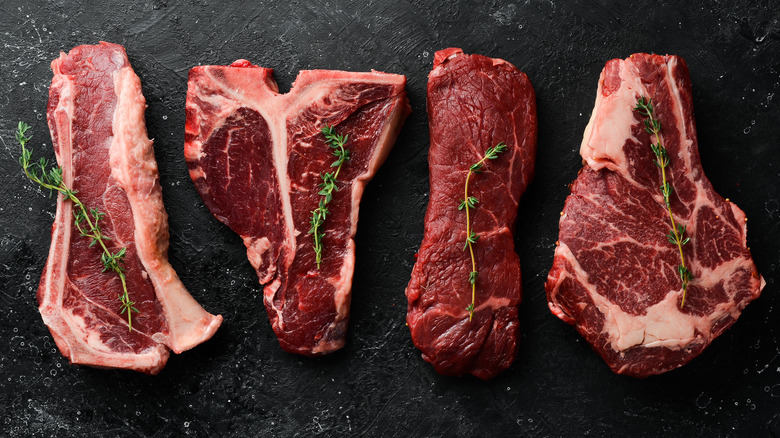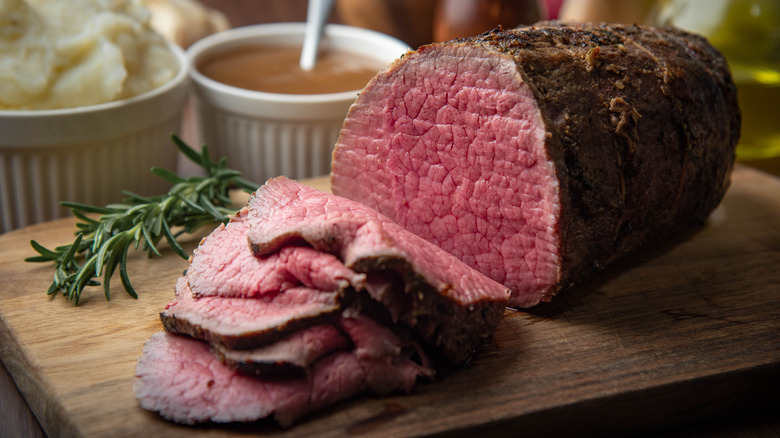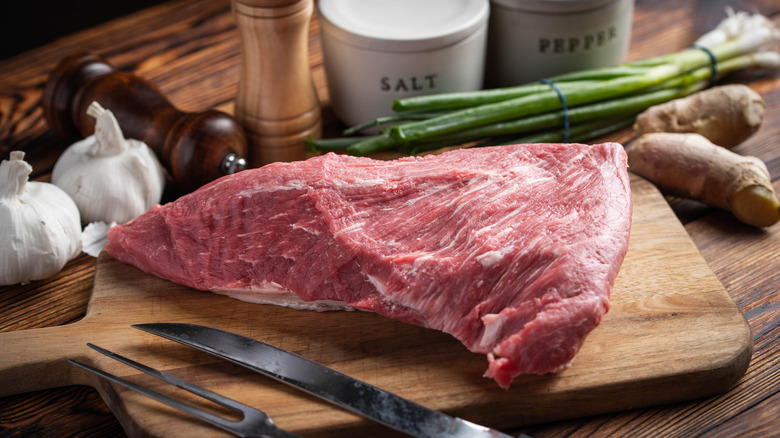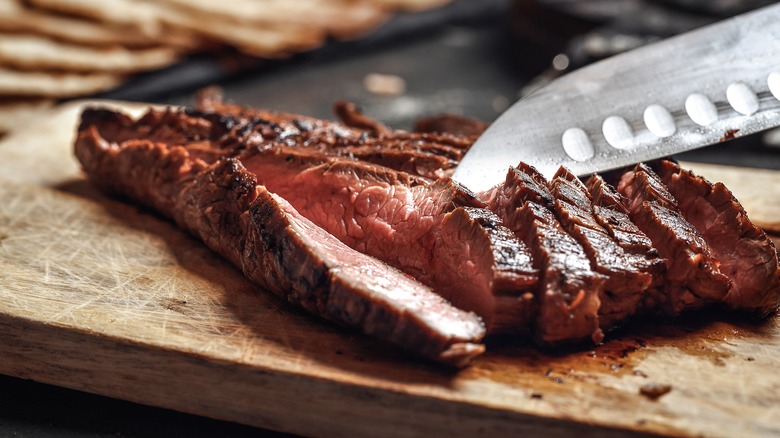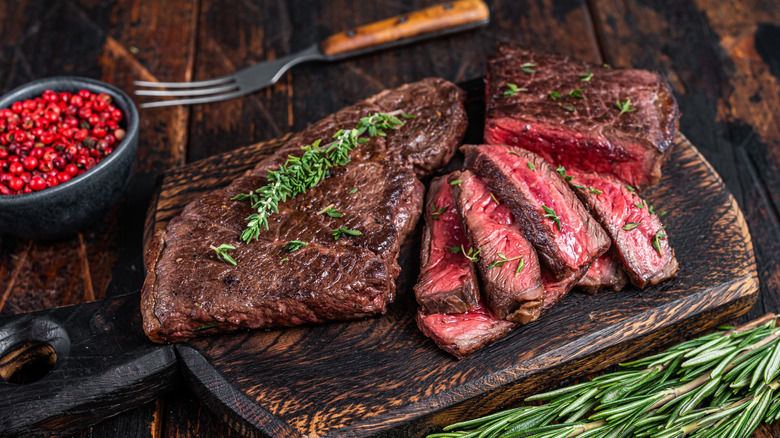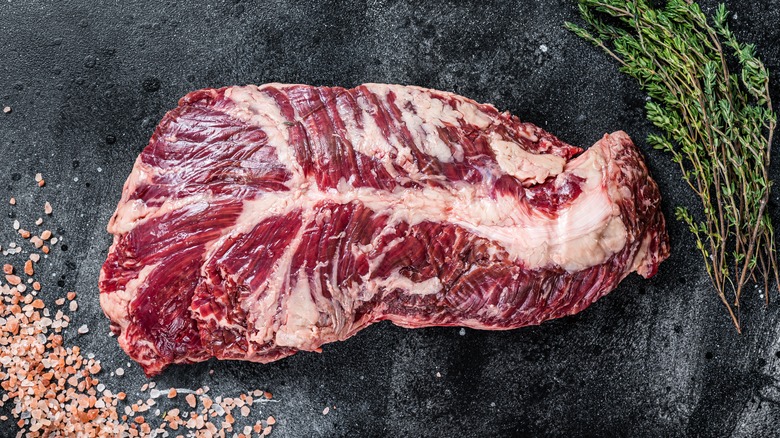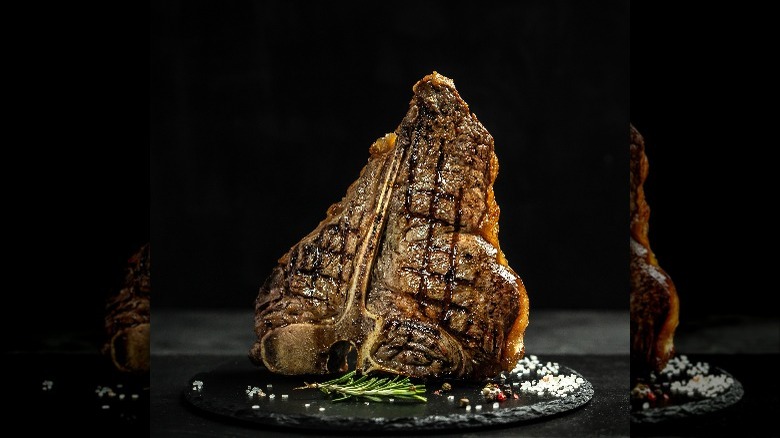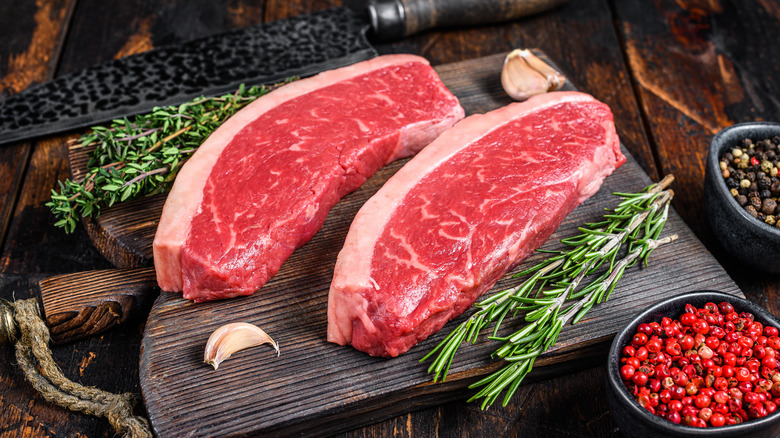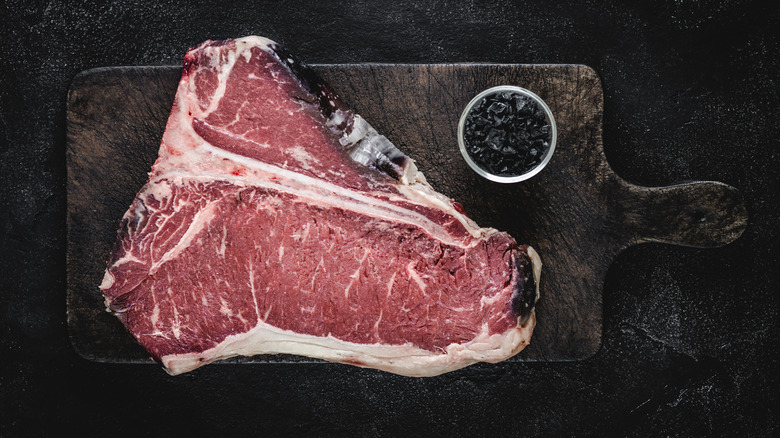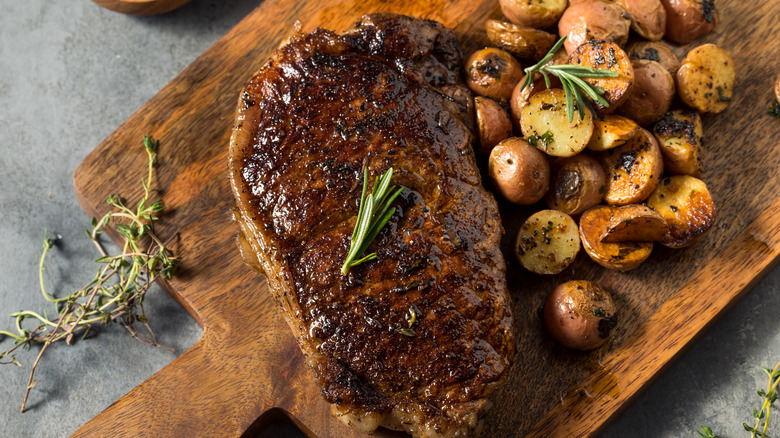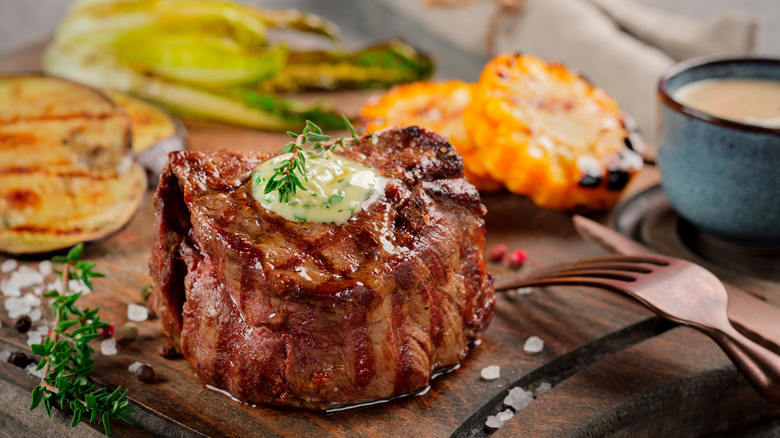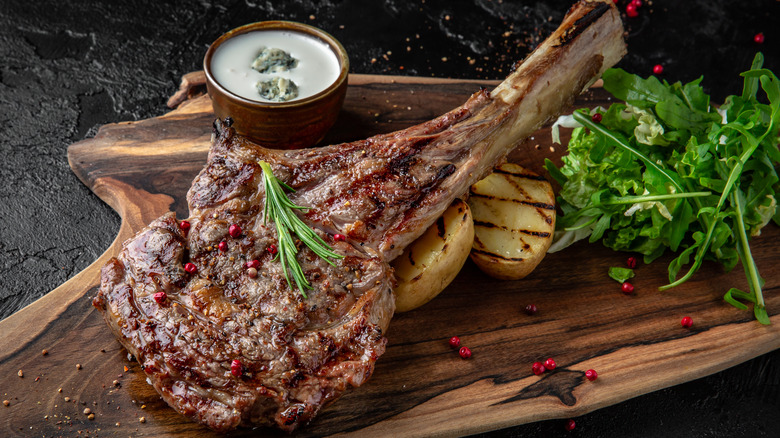Ranking Cuts Of Steak To Pan-Fry From Worst To Best
Unlike other common meats you might find behind the butcher counter, steak has a distinct allure. It's a meal associated with luxury or celebration. We grill steaks during barbecue parties; we visit steakhouses on date-nights; even picking steak as your protein option at many restaurants will likely result in ordering the most expensive option on the menu. Steak, in and of itself, is just a cut of beef meant to be eaten on its own. You don't grind it, slice it up, or shred it — a steak is meant to be cooked, in one piece, and enjoyed as the star of the plate.
There are so many intricacies and specifics to steak depending on where it comes from on the cow. Every steak enthusiast likely has their favorite cut of beef and their favorite way to prepare it, whether it's over a charcoal grill or in a pan right on the stove. As it goes, different cuts of steak tend to stand up better to various cooking methods. In general, not all steaks will grill equally. Likewise, when it comes to pan-frying a piece of beef — arguably one of the easiest and best ways to cook yourself up a steak — some cuts of meat will fare much better than others.
If this sounds like new information to you, a potentially novice steakhouse chef, we've got you covered. We ranked 11 common cuts of steak from worst to best for pan-frying, so your next steak dinner will never disappoint.
Round steak
A round steak, also referred to as eye of round, is one of the more lean and economical cuts of beef you can buy from the butcher. For that reason, it isn't the first cut you think of when you're picking out a juicy steak to barbecue or sear in a cast iron pan with tons of butter. Round steak, sometimes also called London Broil, comes from the bottom or hind legs of the cow. Because it's an area often used by the animal during movement, it isn't as tender as beef from other muscles that don't bear as much weight (via Beef. It's What's For Dinner). As a result, it's pretty easy for a round steak to come out bland and tough if not cooked correctly.
The key to cooking round steaks is to cook it low and slow. When you have a this cut in your refrigerator, you're going to want to pull out your Crock-Pot, dutch oven, or pressure cooker rather than your most bottom-heavy pan for searing. High heat cooking will dry a round steak out in a moment's notice, and this cut needs all the juice that it can get while cooking to keep it moist. It's best when marinated as well, and is often prepared as a roast or for slicing thin. Round steak can be served as a piece of meat on its own, but it will need the added TLC and a nontraditional approach to cooking steak outside the pan.
Tri-tip
Tri-tip steak is one of those cuts of meat that was commonly ground up for stews or burgers, but it has come into fashion as an affordable cut of steak that can be loaded with flavor. Tri-tip, which is sometimes referred to as a poor man's brisket, comes from the bottom tip of the sirloin. It actually has a triangle shape, which is where it gets its name, and usually has a thin side and a thick side. Despite the odd shape, tri-tip is well marbled throughout, meaning that the meat has intramuscular fat that melts during cooking process and adds a savory beef flavor to the meat (via Omaha Steaks). The marbling is key, as tri-tip usually doesn't come butchered with a cap of fat on top like some other cuts, which provides more flavor into the meat.
The best way to cook a tri-tip steak is on the grill, as it is a rustic cut that responds well to simple methods. The black char and smokey flavor pairs so well with this beefy cut. However, it's an oddly-shaped piece of meat to try to sear in a pan. And considering the varying thickness throughout the cut, it's easy to overcook one side of the meat in a pan while the other is still raw. The primal nature of cooking tri-tip steak over the grill allows the person manning the barbecue to monitor the warmer and cooler zones and cook accordingly, giving a little more margin for error.
Flank steak
To the untrained eye, skirt steak, flank steak, and hanger steak can all appear to be the same cut under different names when packaged in the meat aisle of the grocery store (via Grill Simply). However, each one is distinct in its location on the cow, the best methods for cooking, and its use in dishes, so a home chef can't approach each cut the same way. Out of the three, the worst cut for pan-frying is flank steak, which comes from the cow's lower belly region (via Crowd Cow). It's another area that sees a lot of movement, considering it's where the cow's 6-pack abs would be if they had them, which results in a lean piece of meat that is almost too easy to overcook. One benefit is that it is another budget-friendly option that is large and can feed a lot of people, but flank steak almost always needs to be marinated in order to result in the best possible flavor and mouthfeel.
Flank steak cooks relatively quickly, so a pan over high heat isn't the best method. It's best to either cook it low and slow, particularly as a braise, or throw it on the grill for a quick medium-rare sear. It's important that the grill isn't as hot as you might have it for a thick ribeye, but still hot enough to form a little crust on the outside of the beef for added flavor, while allowing the inside to come to temperature.
Skirt steak
Skirt steak is another lean, thin cut that comes from the diaphragm of the cow, just a bit higher up than the flank steak (via Masterclass). Skirt steak just barely beats out flank when it comes to cuts best prepared in a pan because of its intended uses. Skirt steak is most commonly sliced up and used in dishes like fajitas or stir-fry. Sure, you can pan-fry a whole steak and slice it up after, but that technique is best reserved for more marbleized meats that you want to retain their juiciness. Skirt steak tends to soak up the flavor of whatever dish its in, so it's almost better to let each individual strip of beef take on the flavors of its accompanying ingredients.
In a pan, skirt steak does best when it's sliced ahead of time and thrown in to cook quickly. It adds beefy protein to the dish you're making without being overly fussy. If you would rather cook this cut whole, it's best to marinate it ahead of time and cook it quickly on the grill in one piece, considering that its often large and awkward size makes it tough to maneuver in a pan.
Hanger steak
Between flank steak, skirt steak, and hanger steak, the last of the three will do the best when fried in a heavy-bottom pan. The thick hanger steak is the most tender cut of meat on the entire cow, as it "hangs" from the diaphragm and is protected by the ribcage, meaning the animal doesn't utilize it as much during everyday movement and doesn't develop tough muscles in the region (via Beef2Live). A hanger steak is still an optimal cut for the grill because of its odd size, but it tends to be smaller than a skirt steak and fit better into a large pan if that's your preferred method.
Thanks to the tenderness of a hanger steak, it's best to serve this cut of meat medium-rare, which means that high-heat cooking is the way to go for best results. Beef2Live suggests marinating this cut before throwing it on the grill, but not for too long. It is typical for hanger steak to get tough if it is overcooked, but when done right, it can yield surprisingly delicious results because the meat can soak up so much flavor. Of course, you can also make a great hanger steak by searing it in a super hot pan, as long as you keep a close eye on it, reducing the likeliness that you'll end up with a chewy steak dinner. And because of hanger steak's long, thin shape, it might help to cut it in half before cooking in a pan.
Porterhouse
To the untrained eye, a porterhouse and a T-bone steak look nearly indistinguishable. That is because technically all porterhouse steaks are T-bones, but not all T-bones are porterhouses. Both cuts are butchered from the short loin of the cow, and contain both strip steak and tenderloin, including the filet mignon. A T-bone steak separates the sirloin from the filet mignon, so it tends to be smaller than a porterhouse, which contains a bigger section of tenderloin (via Smoked BBQ Source). In general, both cuts are versatile and do well on the grill or in a pan. Plus, they both benefit from having the quintessential look of a big primal steak.
The only reason a porterhouse steak ranks lower on the list is because of its massive size. It is often served as a meal for two people considering the amount of meat on the cut, unless you have a really solid appetite. However, it is extremely marbled with fat and contains that coveted filet mignon section that tastes marvelous when rendered in a high-heat pan. And the bone also adds a lot of flavor to the pan that is absorbed right into the meat. One other thing to keep in mind about porterhouse steaks: It is a bit difficult to make sure that the New York strip and filet remain juicy without being overcooked, as both sides of the meat require generally different cooking times. But the good news is that it's nothing a meat thermometer can't help with.
Sirloin
Sirloin is technically separated into top sirloin, which is typically served as a boneless steak, and bottom butt, which tends to be ground or used in roasts and braises. Bottom sirloin is also where the tri-tip steak is located, so we'll be referring to top sirloin here. This lean cut comes from the cow's spine and isn't filled with as much marbleized fat as a ribeye or a T-bone, meaning it can dry out more easily (via Beef. It's What's For Dinner). For that reason, marinating this cut and cooking it in a high-heat pan until it is medium-rare to medium is the ideal method for cooking sirloin.
The pan-frying method is great for your T-bone steak because it allows you to carefully monitor the internal temperature of the meat while still getting a good crust on the outside. On the other hand, the grilling method can be a bit more unpredictable. The top sirloin is also a good steak to employ the garlic-and-butter-basting method on after it develops a crust — which you can only do in a pan — as it will absorb the flavor and infuse even more moisture into the meaty interior of the steak.
T-Bone
Much like its larger counterpart, the porterhouse, a T-bone steak is the best of both worlds, with a bit of New York strip on one side and the tenderloin on the other. A T-bone has just the right amount of fat to flavor the meat throughout, while the bone adds an undeniable savoriness to the end result (via Rubes Steaks). However, since a T-bone is technically two steaks in one, it is more difficult to ensure even cooking on a grill rather than in a heavy-bottom pan or cast-iron skillet.
If you have an extremely thick T-bone, you can sear it in a pan before finishing in a high-heat oven to the desired doneness. Considering that T-bones are often a bit thinner than a porterhouse, you can usually get away with cooking it in the pan and it'll be done in a matter of minutes. It's important to loosely cover your steak with foil and let it rest a few minutes before cutting so you preserve all of that delicious juice you spent time rendering in the pan (via My Chicago Steak). And by the way, this goes for almost any steak you're cooking, not just a picture-perfect T-bone.
New York strip
Thanks to its compact size, relative thickness, and balanced amount of fat, the New York strip is a perfect cut of steak for frying up in a pan. This cut comes from the short loin on the back of the cow and is very tender due to the fact that it comes from a very underused muscle (via Crowd Cow). It's not as marbled as a ribeye, which is why it doesn't rank higher on the list, but it is a good everyday steak that easily stays juicy in a pan. It's one of the best steaks to practice the reverse searing technique with. This process starts with roasting the steak in the oven to cook the center and then finishing it by searing on the stovetop to form a flavorful crust (via The Washington Post).
Unlike some other cuts of steak that benefit from marinades and complex seasoning mixes, the New York strip is a quality piece of meat that tastes delicious with nothing more than a pinch of salt, pepper, and patience. Sure, you can get creative with it, but this cut should be a staple for all the simple steak dinners in your life.
Filet mignon
The other side of the porterhouse just slightly beats out the New York strip when it comes to best steak to pan-fry — the reputable filet mignon. A filet is small piece of beef from the narrow part of the tenderloin, a muscle that is mostly unused by a cow. The steak is not marbled and doesn't contain a lot of connective tissue, and the pricey cut is often sold in perfectly round and thick medallions that melt in your mouth when done right (via Masterclass).
Filet mignon is easier to overcook on an unpredictable grill, which is considered a sin by some beef enthusiasts who believe this cut should be cooked to no more than medium to medium-rare. Rather, get a cast iron pan over high-heat and sear the outside of your filet until it is perfectly browned. Pan-frying is ideal for the filet because it's harder to mess up, and you are forced to monitor the temperature throughout the entire cooking process.
You can baste your filet with a bit of garlic and butter for added flavor and finish it in a hot oven if you like your steak a little more cooked. Or, while your steak is resting, you can make a pan sauce with the drippings to drizzle on top. once you cook a few filets, you will quickly have it down to a science, and then you can skip the steakhouse visits and still treat your family to a luxurious meal cooked to perfection.
Ribeye
One of the best steaks you can buy, let alone pan-fry, is a flavorful ribeye. The meat is filled with internal marbleized fat that adds flavor and moisture while it's cooked. A ribeye is sold both with and without the bone, but a bone-in ribeye adds even more natural beef flavor during the cooking process. Bone-in ribeyes can also be called cowboy steaks or tomahawks, and are often served with the massive bone sticking out for dramatic effect. As pointed out by My Chicago Steak, it's important to note that the meat closer to the bone takes longer to heat and cool, which can affect the overall temperature and texture of your steak. A meat thermometer can help you ensure that each section is cooked to your desired doneness, but it is helpful to take the temperature of multiple areas on the piece of meat.
Pan-frying a ribeye is one of the best ways to learn how to cook a good steak without all the extras. Because of all that beautiful intramuscular fat and the liquid gold that is bone marrow, this steak only needs some salt and pepper to make it sing. The pan helps capture that all the delicious juice making for an extra juice and flavorful steak, as long as you let it rest. When you're lost in front of the meat counter and don't know what to buy, you can almost never go wrong by picking up a ribeye and firing up a hot pan.
